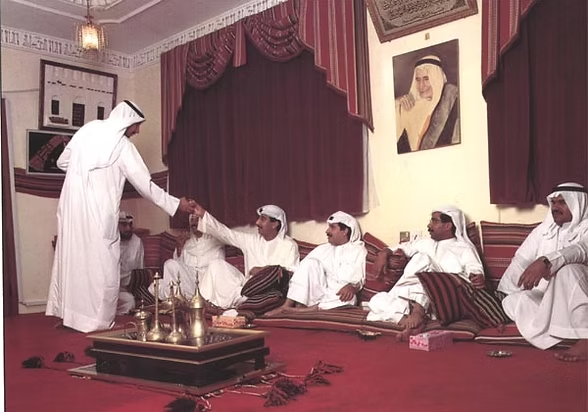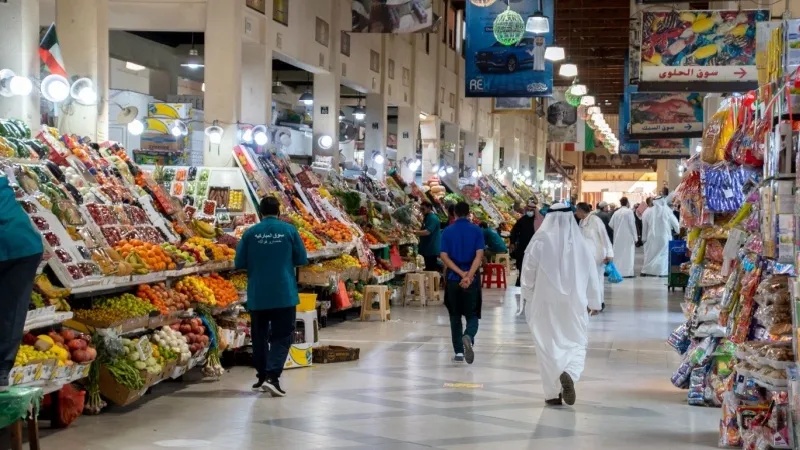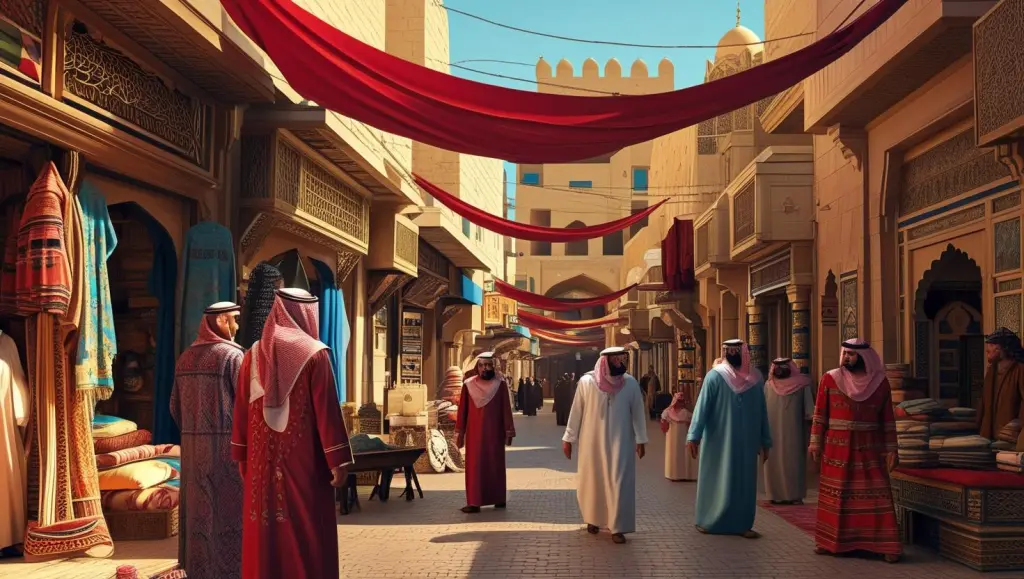The Cultural Essence of Kuwaiti Clothing
Traditional Kuwaiti clothing reflects more than just style it embodies the nation’s soul, heritage, and pride. Every thread, color, and fabric choice represents centuries of tradition, shaped by the harsh desert climate, Islamic values, and Bedouin roots. In a rapidly modernizing world, Kuwait has managed to preserve its traditional attire as a living symbol of identity and cultural unity. Whether worn in daily life, during festivals, or on national occasions, Kuwaiti clothing continues to connect people with their history and values.
Kuwaiti attire is elegant yet modest, with designs carefully tailored to respect Islamic principles. It reflects a perfect harmony between function and fashion providing comfort in the hot climate while showcasing artistic beauty through embroidery, patterns, and accessories. The symbolism within each piece tells a story of Kuwait’s social fabric, economic past, and cultural pride that transcends generations.
The Men’s Traditional Dress: Dishdasha and Its Distinction
For Kuwaiti men, the Dishdasha also known as thobe is a timeless garment. It is a long, ankle-length robe with a straight cut, typically made from cotton or wool depending on the season. While it may appear simple, the Dishdasha is a masterpiece of practicality and grace. Its design ensures comfort during Kuwait’s scorching summers and warmth during cooler months.
What truly sets the Kuwaiti Dishdasha apart is its attention to detail. Unlike other Gulf styles, Kuwaiti Dishdasha often features a more fitted shoulder, sleek front buttons, and an understated elegance that symbolizes dignity and cleanliness. The colors vary by season light hues such as white, beige, and cream dominate the summer, while darker tones like grey and navy are preferred in winter.
Men often accessorize their Dishdasha with a ghutra or shemagh (headscarf), secured with an agal, a black cord. The way it is folded or draped can represent regional identity, personal taste, or even social status. This combination of simplicity and symbolism reflects the Kuwaiti value of modesty blended with confidence.
The Women’s Traditional Attire: Grace and Grandeur in Every Stitch
Kuwaiti women’s traditional clothing is a striking expression of femininity, elegance, and cultural pride. The most iconic attire is the Daraa a long, flowing dress often adorned with golden or silver embroidery. Worn at home or on special occasions, the Daraa represents the beauty of Kuwaiti craftsmanship, with each pattern symbolizing prosperity, happiness, and grace.
For public outings, women often wear an abaya, a black cloak that signifies modesty and respect. It is usually paired with a hijab or shayla (headscarf) that complements the abaya’s design. Kuwaiti women, however, have mastered the art of balancing tradition with fashion modern abayas now feature intricate embroidery, luxurious fabrics, and elegant cuts, showcasing individuality while preserving cultural values.
On festive occasions such as Eid or weddings, women wear the Thobe Al-Nashal, a traditional ceremonial gown woven with gold threads and often decorated with elaborate patterns. This stunning attire is more than just a dress it’s a symbol of pride, celebration, and the artistry of Kuwaiti heritage passed down through generations.

The Symbolism Behind Colors and Fabrics
Colors in Kuwaiti clothing are deeply symbolic and culturally expressive. White, the most common color, represents purity and peace. It is also practical, reflecting sunlight and keeping the body cool during Kuwait’s hot seasons. Black, often seen in women’s abayas, symbolizes elegance and modesty, complementing the principles of Islamic culture.
During festivities, bright colors like gold, red, green, and turquoise dominate women’s garments, symbolizing joy, prosperity, and life. These vibrant shades are believed to bring happiness and good fortune. The choice of fabric also holds meaning cotton for comfort, silk for elegance, and wool for endurance during winter.
Each fabric tells a story about Kuwait’s historical trade connections. Silk and brocade, once imported through ancient trade routes, highlight the country’s strategic position as a link between the East and West. These materials became a part of Kuwait’s identity, representing luxury and global influence while maintaining local authenticity.
Accessories: The Finishing Touches of Tradition
No Kuwaiti outfit is complete without its accessories, which carry their own symbolic and aesthetic significance. Men often wear simple, practical additions such as the bisht, a cloak worn over the Dishdasha during formal occasions or by elders and leaders. Made from fine wool, the bisht signifies authority, wisdom, and social respect.
Women’s accessories, on the other hand, showcase Kuwait’s rich artistic culture. Traditional jewelry made from gold, pearls, and gemstones holds sentimental and cultural value. Kuwait’s historic association with pearl diving gives special importance to pearl ornaments, symbolizing beauty, purity, and the nation’s maritime heritage.
Common adornments include headpieces like mishlah or bukhnuq, decorated with sequins or golden thread, and bracelets, anklets, and earrings that sparkle with traditional motifs. These pieces are not merely ornaments they are treasures of identity, often passed down as family heirlooms representing love, continuity, and prosperity.
The Evolution of Kuwaiti Fashion
While Kuwait remains deeply rooted in its traditions, its fashion scene has evolved remarkably over the decades. The younger generation, inspired by global trends, has found creative ways to modernize traditional attire without losing its cultural essence. Fashion designers across Kuwait now blend old and new, creating stunning fusions of tradition and contemporary style.
Modern versions of the Dishdasha may include slimmer fits and custom fabrics, reflecting global fashion while maintaining national pride. Similarly, abayas are now designed with creative patterns, colorful linings, and intricate embroidery, appealing to modern sensibilities while preserving modesty. This evolution shows Kuwait’s ability to adapt and innovate while cherishing its cultural values.
In today’s Kuwait, traditional attire has become a statement of identity worn proudly in public events, national celebrations, and even global fashion showcases. The younger generation’s enthusiasm for preserving traditional fashion demonstrates their deep respect for their heritage, proving that culture can evolve without fading.
Traditional Clothing in Modern Celebrations
Kuwait’s traditional clothing takes center stage during cultural and national celebrations. On National Day and Liberation Day, men and women often wear their traditional attire to express unity and pride. The streets and gatherings become vibrant with colors, fabrics, and patterns, reminding everyone of the beauty of Kuwaiti heritage.
During weddings, traditional dresses like the Thobe Al-Nashal and heavily embroidered Daraas are essential. These outfits are often custom-made to reflect the bride’s family heritage and social identity. Even men wear specially tailored Dishdashas with a bisht to mark the importance of the occasion.
In religious festivals like Eid Al-Fitr and Eid Al-Adha, families dress in new traditional garments as a symbol of renewal and gratitude. The joy of wearing these clothes connects generations elders passing down cultural pride to the youth through fashion that never goes out of style.
The Role of Women in Preserving Traditional Fashion
Kuwaiti women have played an instrumental role in keeping traditional clothing alive. Through their creativity, craftsmanship, and cultural commitment, they have turned clothing into an art form. Many women’s cooperatives and local artisans continue to produce hand-embroidered garments using techniques passed down through families.
These women not only preserve the heritage but also empower the local economy. The art of Talli (traditional embroidery) and Sadu weaving a Bedouin textile craft reflect the strength of Kuwaiti women and their influence in maintaining the nation’s cultural legacy. Through workshops, exhibitions, and online platforms, they are ensuring that future generations remain connected to their roots.
In the modern fashion scene, many female Kuwaiti designers have emerged, showcasing the fusion of tradition and innovation. They celebrate modesty while promoting creative expression, making traditional Kuwaiti clothing a source of empowerment and identity for women across the world.

The Spiritual and Social Symbolism of Dress
In Kuwaiti culture, clothing is not just an outer covering it represents inner values. Modesty, humility, respect, and unity are reflected in how people dress. The way an individual wears their traditional attire shows not only their style but also their understanding of cultural respect and faith.
For men, wearing the Dishdasha in daily life signifies discipline and simplicity, core values that align with Kuwait’s social structure. For women, dressing modestly yet elegantly shows grace, self-respect, and spiritual strength. These values connect the past and present, creating a shared sense of belonging and moral harmony.
Traditional Kuwaiti clothing also strengthens community ties. It brings people together during national celebrations, religious gatherings, and family events. The collective experience of wearing traditional attire deepens social bonds and reminds everyone of their shared history and mutual respect.
The Global Appreciation of Kuwaiti Fashion
In recent years, Kuwaiti traditional fashion has gained international recognition. Designers and artists have showcased Kuwaiti attire on global platforms, celebrating its intricate craftsmanship and deep symbolism. The world is beginning to recognize Kuwait not only for its modern development but also for its timeless cultural elegance.
Fashion exhibitions in the Gulf and beyond have featured Kuwaiti garments as examples of how tradition can harmoniously meet innovation. Many international designers draw inspiration from the simplicity and sophistication of the Dishdasha or the intricate details of the Daraa and Thobe Al-Nashal. This global appreciation highlights how clothing can serve as a bridge between cultures, promoting understanding and admiration across borders.
A Living Heritage for the Future
Despite modernization, Kuwait continues to preserve its traditional fashion as an integral part of its national identity. Government initiatives, cultural festivals, and educational programs play a crucial role in passing down this heritage to younger generations. Schools and museums often highlight traditional attire as symbols of pride, resilience, and cultural depth.
The younger generation’s embrace of traditional fashion shows that heritage can evolve beautifully. From luxury fashion boutiques to family celebrations, Kuwaiti clothing continues to tell stories of courage, creativity, and cultural pride. As time passes, these garments remain timeless reminding Kuwaitis of who they are and where they come from.
Conclusion: Threads That Bind a Nation
Exploring traditional Kuwaiti clothing is like reading the story of the nation woven in gold, silk, and pride. It reveals Kuwait’s deep respect for faith, family, and identity while embracing modern influences with grace. Every Dishdasha, Daraa, and Thobe Al-Nashal is a reminder of Kuwait’s journey from desert sands to global elegance.
These garments are more than mere fashion they are a language of belonging, dignity, and cultural strength. They remind every Kuwaiti that tradition is not a thing of the past but a living art that continues to define the present and inspire the future. Through their clothing, Kuwaitis celebrate who they are a people of beauty, resilience, and timeless elegance.
Do follow Gulf Magazine on Instagram.
Also Read – Embracing Warmth: How Kuwaiti Hospitality Shapes National Pride



